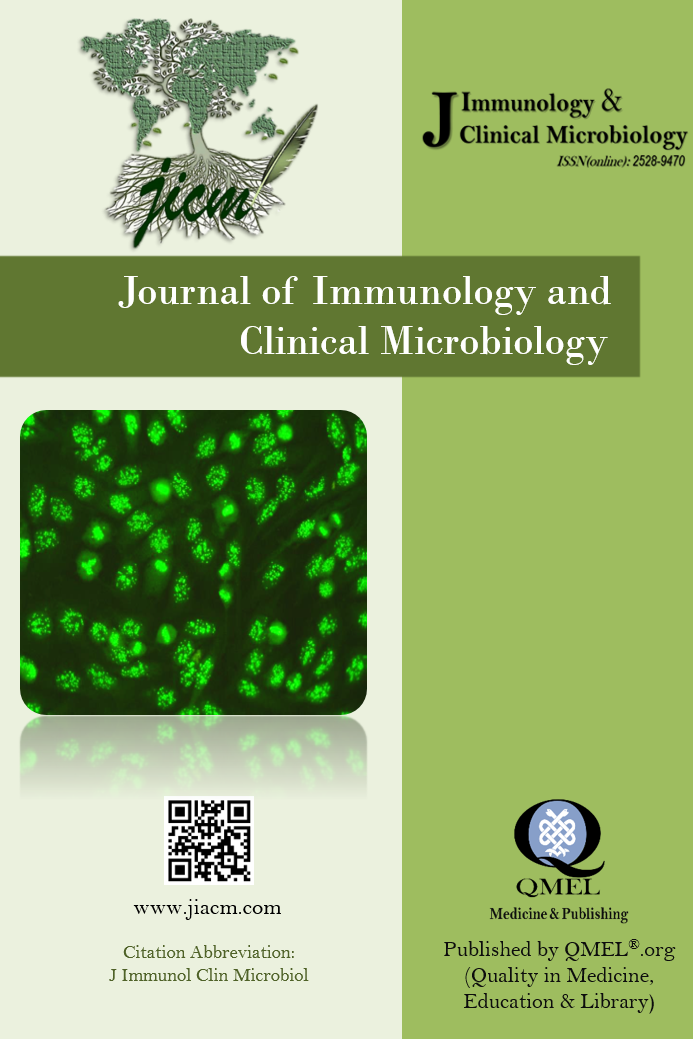Testing for Lyme borreliosis: could serology tell more?
Testing for Lyme borreliosis: could serology tell more?
serology, Lyme borreliosis, differential diagnosis,
___
- Eldin C, Raffetin A, Bouiller K, Hansmann Y, Roblot F, Raoult D, et al. Review of European and American guidelines for the diagnosis of Lyme borreliosis. Médecine Mal. Infect. 2019 1;49:121–32. doi: 10.1016/j.medmal.2018.11.011
- Two-step Laboratory Testing Process | Lyme Disease | CDC [Internet]. 2018 21 [cited 2019 14];doi: https://www.cdc.gov/lyme/diagnosistesting/labtest/twostep/index.html
- Lohr B, Fingerle V, Norris DE, Hunfeld K-P. Laboratory diagnosis of Lyme borreliosis: Current state of the art and future perspectives. Crit. Rev. Clin. Lab. Sci. 2018;55:219–45. doi: 10.1080/10408363.2018.1450353
- Wilking H, Fingerle V, Klier C, Thamm M, Stark K. Antibodies against Borrelia burgdorferi sensu lato among Adults, Germany, 2008–2011. Emerg. Infect. Dis. 2015;21:107–10. doi: 10.3201/eid2101.140009
- Zając V, Pinkas J, Wójcik-Fatla A, Dutkiewicz J, Owoc A, Bojar I. Prevalence of serological response to Borrelia burgdorferi in farmers from eastern and central Poland. Eur. J. Clin. Microbiol. Infect. Dis. 2017;36:437–46. doi: 10.1007/s10096-016-2813-7
- 6. Bušová A, Dorko E, Rimárová K, Diabelková J, Rovenská T, Feketeová E, et al. Seroprevalence of Lyme disease in Eastern Slovakia. Cent. Eur. J. Public Health 2018;26 Suppl:S67–71. doi: 10.21101/cejph.a5442
- 7. Jacek E, Tang KS, Komorowski L, Ajamian M, Probst C, Stevenson B, et al. Epitope-Specific Evolution of Human B Cell Responses to Borrelia burgdorferi VlsE Protein from Early to Late Stages of Lyme Disease. J. Immunol. Baltim. Md 1950 2016 1;196:1036–43. doi: 10.4049/jimmunol.1501861
- Philipp MT, Bowers LC, Fawcett PT, Jacobs MB, Liang FT, Marques AR, et al. Antibody response to IR6, a conserved immunodominant region of the VlsE lipoprotein, wanes rapidly after antibiotic treatment of Borrelia burgdorferi infection in experimental animals and in humans. J. Infect. Dis. 2001 1;184:870–8. doi: 10.1086/323392
- Peltomaa M, McHugh G, Steere AC. Persistence of the antibody response to the VlsE sixth invariant region (IR6) peptide of Borrelia burgdorferi after successful antibiotic treatment of Lyme disease. J. Infect. Dis. 2003 15;187:1178–86. doi: 10.1086/374376
- Moore A, Nelson C, Molins C, Mead P, Schriefer M. Current Guidelines, Common Clinical Pitfalls, and Future Directions for Laboratory Diagnosis of Lyme Disease, United States. Emerg. Infect. Dis. 2016;22. doi: 10.3201/eid2207.151694
- Seriburi V, Ndukwe N, Chang Z, Cox ME, Wormser GP. High frequency of false positive IgM immunoblots for Borrelia burgdorferi in Clinical Practice. Clin. Microbiol. Infect. 2012 1;18:1236–40. doi: 10.1111/j.1469-0691.2011.03749.x
- Lakos A. [Lyme borreliosis--experience of the last 25 years in Hungary]. Orv. Hetil. 2009 19;150:725–32. doi: 10.1556/OH.2009.28576
- Kalish RA, McHugh G, Granquist J, Shea B, Ruthazer R, Steere AC. Persistence of immunoglobulin M or immunoglobulin G antibody responses to Borrelia burgdorferi 10-20 years after active Lyme disease. Clin. Infect. Dis. Off. Publ. Infect. Dis. Soc. Am. 2001 15;33:780–5. doi: 10.1086/322669
- Lakos A, Reiczigel J, Solymosi N. The positive predictive value of Borrelia burgdorferi serology in the light of symptoms of patients sent to an outpatient service for tick-borne diseases. Inflamm. Res. Off. J. Eur. Histamine Res. Soc. Al 2010;59:959–64. doi: 10.1007/s00011-010-0209-1
- Yayın Aralığı: Yılda 4 Sayı
- Başlangıç: 2016
- Yayıncı: Erkan YULA
Hypersensitivity pneumonitis following intravesical BCG immunotherapy
Adem SANCI, Eralp KUBİLAY, Efe OĞUZ, Başak GÜLPINAR
Testing for Lyme borreliosis: could serology tell more?
András ZÓKA, Márton GÖNCZY, Veronika BARBAİ, Radka NİKOLOVA, Eszter UJHELYİ, Zsuzsa KİENLE, Gabriella BEKŐ
Samsun Bölgesindeki Çocuk ve Yetişkinlerde Bruselloz Olgularının Seroprevalansı
